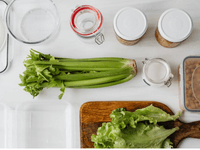How to Pass Your Food Hygiene Inspection on the First Try
Table of Contents
CloudKitchens
How many tacos can be delivered from a 1000sqft restaurant?
The same amount as a 200sqft ghost kitchen.
From cleaning checklists to staff protocols, learn how to meet food safety standards, avoid common pitfalls, and impress your inspector.
Passing a food hygiene inspection is essential for any food business. These inspections verify that your operation meets food safety standards to protect customers and maintain your brand’s reputation. While the process may seem daunting, proper preparation can make all the difference.
This guide provides a clear, practical overview of what to expect during an inspection, common mistakes to avoid, and key steps to prepare your kitchen.
You’ll also learn about the benefits of using compliant, well-maintained kitchen spaces designed to simplify the inspection process and support business growth.
With the right knowledge and tools, passing your food hygiene inspection on the first try is achievable. Let’s explore how to incorporate compliance smoothly into your daily operations.
Read More: What a HACCP plan for commercial kitchens means and how to implement it
Understanding Food Hygiene Inspections
Food hygiene inspections are assessments conducted by health authorities to ensure a restaurant follows kitchen sanitation standards. They play a crucial role in guaranteeing the safety of the food served to customers.
These standards are set by agencies such as the FDA in the United States, which publishes a code used as a foundation for state and local regulations.
Other organizations, like the CDC and USDA, also provide guidelines that influence the hygiene requirements restaurants must meet.
Local agencies are responsible for enforcing these regulations through routine health department inspections. The frequency of these visits depends on the type of establishment, its compliance record, and any complaints from customers.
For delivery-focused kitchens, including ghost kitchens, adhering to these standards is especially important. Any lapse can directly impact food safety, damage the brand’s reputation, and disrupt business operations.
Below are the main areas reviewed during a health inspection to ensure food safety compliance:
- Food Storage and Handling: Inspectors check if raw, cooked, and ready-to-eat foods are properly separated and stored in clean, labeled containers. They also verify correct handling practices, such as the use of gloves and separate utensils to avoid cross-contamination.
- Temperature Control: They ensure that perishable foods are kept within safe temperature ranges, both during storage and preparation. Cold foods must be refrigerated, while hot foods need to be maintained above a minimum temperature to prevent bacterial growth.
- Kitchen Cleanliness and Organization: The inspection assesses whether countertops, floors, equipment, and utensils are regularly sanitized and in good working condition. A disorganized kitchen with dirt or waste buildup poses a sanitary risk and may result in failure.
- Employee Hygiene: Staff must follow basic hygiene practices, such as frequent hand washing, wearing clean uniforms, hairnets, and keeping nails short. Failure to comply can increase the risk of direct food contamination.
- Pest Prevention: The establishment must demonstrate an effective pest control plan, including physical barriers, traps, and regular pest control services. Signs of infestation, like rodent droppings or live insects, lead to immediate penalties.
Common Reasons Food Businesses Fail Hygiene Inspections
Even experienced businesses can fail an inspection if basic daily practices are overlooked. Below are the most common errors and how to keep your kitchen compliant:
Improper Food Storage
Storing raw foods alongside ready-to-eat products, using dirty containers, or keeping expired items are serious mistakes. These practices promote cross-contamination and indicate poor ingredient safety control.
How to avoid: Organize storage by separating raw, ready-to-eat, and perishable foods into different areas. Use clean containers labeled with expiration dates and apply the FIFO (First In, First Out) system.
Poor Sanitization of Equipment and Utensils
Dirty equipment and utensils accumulate food residues and bacteria, posing health risks to consumers. Reusing cutting boards, knives, and blenders without proper cleaning is a frequent cause of violations.
How to avoid: Implement a kitchen cleaning schedule with approved cleaning products. Ensure all utensils receive complete washing before reuse.
Unsanitary Kitchen Surfaces
Greasy floors, dirty countertops, and buildup in kitchen corners reflect operational neglect. These conditions encourage microorganism growth and leave a poor impression during inspections.
How to avoid: Establish a detailed cleaning schedule with daily tasks, proper products, and assigned personnel. Document sanitization actions as part of your routine records.
Cross-Contamination
This occurs when the same utensil is used for raw and cooked foods or when handlers don’t properly wash their hands between tasks. Such lapses drastically increase the risk of pathogen transmission.
How to avoid: Separate utensils and surfaces by type, using color-coded systems if necessary. Train staff to change gloves, wash hands regularly, and follow best food safety practices consistently.
Inadequate or Missing Labeling
Unlabeled foods make it difficult to control expiration dates and proper use, besides compromising traceability in case of incidents. This shows disorganization and weak supply management.
How to avoid: Create standard labels with product name, preparation date, and expiration date. Establish routines to check and discard expired or unlabeled items.
Pest Infestation
Signs of cockroaches, flies, ants, or rodents indicate serious structural or waste management failures. This is one of the most severe violations and can lead to immediate closure.
How to avoid: Schedule regular pest control treatments, keep drains closed, store trash properly, and maintain a clean kitchen. Record pest control company visits as part of compliance documentation.
Lack of Required Documentation
Missing records like cleaning checklists, temperature logs, or staff training certificates can lead to fines. Even if good practices are followed, lack of proof can cause failure.
How to avoid: Keep all documents organized in physical or digital files for easy access. Regularly update spreadsheets and reports, and be ready to present them when requested.
Preparing Your Kitchen for Inspection
The best way to pass a food hygiene inspection is to always be ready, as if the inspector could arrive at any moment. This means adopting a consistent routine of good practices involving organization, cleaning, record-keeping, and attention to operational details.
Pay close attention to key points that must be adjusted before the inspection, as they can make all the difference in the final result.
Organizing Food Storage and Handling Practices
The FDA requires foods to be stored and handled to prevent cross-contamination, spoilage, and public health risks. During the inspection, the officer will observe how products are labeled, organized, and kept at safe temperatures.
- Separate raw foods from ready-to-eat items, using dedicated shelves.
- Keep cold foods at 41°F (5°C) or below and hot foods at 135°F (57°C) or above.
- Use labels with food name, preparation date, and discard date.
- Use exclusive utensils and surfaces for meats, vegetables, and cooked foods.
- Store ingredients in clean, covered containers elevated off the floor.
- Apply the FIFO (First In, First Out) method for proper stock rotation.
Maintaining Cleanliness and Sanitation Standards
U.S. health codes require sanitized surfaces, pest control, and safe waste management. Poor cleaning is a leading cause of violations and can result in immediate notices, fines, or business closure.
- Implement a cleaning and disinfection schedule for preparation areas and equipment.
- Sanitize utensils, countertops, and machines with EPA-approved solutions.
- Keep cleaning logs accessible for inspectors to review.
- Schedule regular visits from licensed pest control companies.
- Maintain covered, lined trash bins away from food prep areas and empty them frequently.
- Install physical barriers on doors, drains, and windows to prevent insect and rodent entry.
Read More: 5 Important Elements for Restaurant Branding
Tips to Pass Your Food Hygiene Inspection on the First Try
Passing a hygiene inspection on the first visit is achievable with continuous organization and attention. The key to successful food inspection preparation is keeping your business aligned with regulations every day, not just on inspection day, by following these tips:
Keep Records Updated
Document all food safety activities such as cleaning, temperature monitoring, training, and audits. Having these records organized and accessible makes it easier to prove compliance during inspections.
Conduct Regular Internal Audits
Perform frequent reviews to spot and fix issues before the inspector arrives. Involving your team promotes shared responsibility and prevents unpleasant surprises.
Use Technology for Monitoring
Adopt software and apps that help track deadlines, log important data, and send alerts for necessary actions. This streamlines management and lowers error risk.
Invest in Continuous Staff Training
Ensure all employees understand food safety training rules and procedures thoroughly. Well-trained teams make fewer mistakes and respond better to inspection requirements.
Maintain a Collaborative Attitude with Inspectors
Welcome inspectors professionally, listen to their recommendations, and promptly address any problems. This approach shows commitment and can ease the approval process.
How CloudKitchens Supports Compliance and Hygiene
CloudKitchens facilities are designed to let operators focus on food production without worrying about sanitation issues. Specialized teams handle regular cleaning, keeping all areas in optimal condition for safe kitchen operation.
Preventive maintenance is also a constant priority. Equipment is monitored and serviced to avoid failures that could compromise food safety or disrupt operations. This greatly reduces the risk of failing health inspections.
The infrastructure includes advanced systems for temperature control, proper ventilation, and waste management. These features help ensure compliance with local, state, and federal regulations, providing a hygienic and efficient environment for food preparation.
With this integrated support, operators can focus on growing their delivery businesses, confident they are working in kitchens that meet all sanitary requirements.
Take the Stress Out of Food Hygiene Inspections Today
Maintaining compliance with health standards is essential but doesn’t have to be a burden. With the right facilities and professional support, you can minimize risks and operate with greater peace of mind.
CloudKitchens offers environments designed to simplify legal compliance, reducing the effort needed for cleaning, maintenance, and site management.
For those seeking efficiency and safety, exploring CloudKitchens locations is the first step toward transforming your business routine. Talk to our experts and discover how a compliant kitchen space can be the ideal solution for your delivery operation.
FAQ – Passing Food Hygiene Inspections
What are the most common reasons food businesses fail hygiene inspections?
Common issues include improper food storage, lack of cleanliness, poor employee hygiene, and inadequate pest control.
How can I prepare my staff for a hygiene inspection?
Train them on proper sanitation practices, food handling procedures, and the importance of following health regulations consistently.
What should I do if my business doesn’t pass the first inspection?
Address all cited violations promptly, document corrective actions, and schedule a re-inspection while maintaining ongoing compliance.
DISCLAIMER: This information is provided for general informational purposes only and the content does not constitute an endorsement. CloudKitchens does not warrant the accuracy or completeness of any information, text, images/graphics, links, or other content contained within the blog content. We recommend that you consult with financial, legal, and business professionals for advice specific to your situation.
More insights & stories
There’s more where that came from.
Get in the know and check out our additional insights




